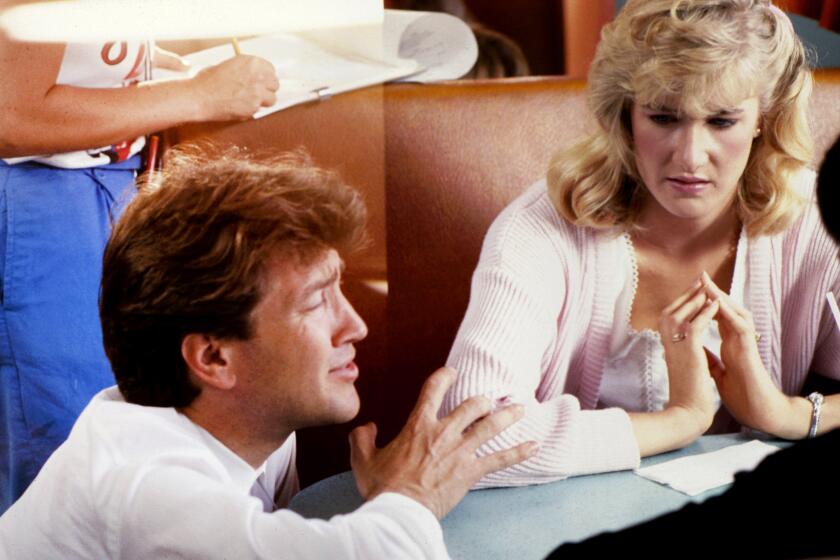YORKIN’S DARE OF A ‘LIFETIME’
- Share via
It is an act of faith just shy of madness to finance, produce, direct and distribute your own film. It is particularly brave, or foolish, in a day when audience tastes are finicky at best and the established wisdom is that adult problems are of no interest whatever to the juveniles who buy most of the tickets anyway.
On the other hand, being your own boss means just that, and whatever else is true, Bud Yorkin’s “Twice in a Lifetime” is the film he wanted to make, made the way he thought it should be made.
I suspect that some of his pals, taking meeting after meeting in their desperate assault on the forces of timidity and indecision in the top ranks of the industry, look with envy on Yorkin, now that “Twice in a Lifetime” has opened to brisk business and generally if not universally positive reviews.
Yorkin, who prospered in partnership with Norman Lear in their Tandem Productions, making films (“Start the Revolution Without Me”) and television shows, had stumbled onto a script by Colin Welland, done originally as a script produced on British television. But Welland, who also wrote “Yanks” and “Chariots of Fire,” then spent some time in a Pennsylvania steel town, translating the story to this country and into a film.
Not the least of Yorkin’s daring, I think, was becoming enthused about a very, very familiar theme: the middle-aged marriage succumbing to its own duration, and leaving one or both partners vulnerable to new loves and to hard and wrenching change. Then again, there aren’t that many basic themes going around; it’s the specifics that matter.
What I liked from the start was that Welland and Yorkin sidestepped the affluent middle class where the movies customarily espy their marital dramas. But their blue-collar protagonist, Gene Hackman, is neither patronized nor sanctified. He is what he is: a steady, tax-paying, mortgage-minding, Seattle steelworker who has begun to feel his life slipping through his fingers like sand.
Is it probable that Ann-Margret, the voluptuous new barmaid at the neighborhood saloon, would fall for a shy and ordinary Joe like Hackman? Well, why not? When you’ve been teased, chased, pawed, conned and betrayed from 7th grade up, a little politeness goes a long way.
What’s definite is that the observation of the ordinary doesn’t carry you very far dramatically, and there are some loud confrontations in “Twice in a Lifetime,” theatrical and operatic, the noisiest of them centering on Amy Madigan as the daughter who (out of her own anxieties, you feel) can’t accept what is happening at home and wants to browbeat dad back to the status quo. How unlovely that would likely be for everybody doesn’t slow her; but in this, as in much else, Welland’s script seems very accurately observed.
The pain throughout the middle stretches of “Twice in a Lifetime” is palpable, and the suspense, the real suspense, is in waiting to see how at last Hackman will deal with it. It’s like pulling off a kind of spiritual adhesive tape: Do you stop and go back to where the pain was only dull, or rip away in the hope of easeful times thereafter?
In an earlier day, such was the enforcement of togetherness mandated by the moguls that one or the other of the sinning partners would have been erased by a truck or a noble sacrifice, or both would have seen the error of their ways. Let “Brief Encounter” be the epitome of the older view. It was not that Celia Johnson’s return to the normalcy of her place at her featureless husband’s side--listening to the wireless in the living room--was preferable, it was that it was inevitable.
The happy ending is not what it used to be. Indeed it has been a while since the movies said, with any real conviction, that they lived happily ever after. And there are matters left uncertain in “Twice in a Lifetime.”
It is not clear that a new hairdo and an outing at a male strip club will really propel Ellen Burstyn as the wife back into the romantic mainstream (it is the cruelest time for the single woman who does not wish to be single). It is not clear how corrosive Hackman’s guilts will be.
But it’s precisely the felt pain and the lingering ambiguities that give Welland’s story and Yorkin’s film, for all the dramatic embellishments, its fundamental ring of accuracy, its sense that like it or not, this is the way life is presently lived. It is told without preachment.
Win or lose, the only point to putting yourself at risk as Yorkin has is to come away with a film you can be proud of. And while there may be some tinkering he would wish he could do (another film maker once remarked that you never finish a film, you only finally have to surrender it), I hazard a guess that Yorkin is very proud of “Twice in a Lifetime.”
More to Read
Only good movies
Get the Indie Focus newsletter, Mark Olsen's weekly guide to the world of cinema.
You may occasionally receive promotional content from the Los Angeles Times.










